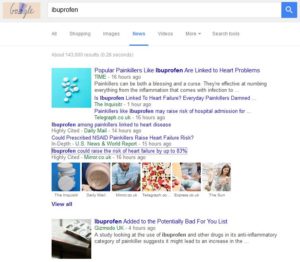via GIPHY
Exhibit A
Today (finally!) a J. Neurosci. paper I’ve been battling to get retracted for over 3 years was finally removed from the literature. Cause for celebration right? Not exactly. The following is a quote from the former Editor in Chief of the journal back in 2013…
The SfN requested institutional investigations […] institutions produced detailed reports that included the original images used to construct the figures. The images clearly documented that the figure elements that appeared to be replicates in the article in J. Neurosci. were in fact from different gels. Because there was no evidence that any results had been misrepresented, the SfN has dismissed the case. We consider the matter closed.
What followed (outlined in part here) was a long and protracted battle between YHN and the journal, eventually resulting in the SfN ethics committee (which oversees ethics at the journal) re-engaging the case. This was followed by another couple of years of them ignoring my emails, during which time J. Neurosci got a new EiC who claimed not to know about the case. The paper has been cited 77 times during the 3 & 1/2 years it’s been allowed to pollute the literature.
The retraction notice reads:
It was brought to our attention that the Donmez et al., 2012 paper has numerous examples of unindicated splicing of gel lanes and of duplications and inversions of gel images. The prevalence of these occurrences is unacceptable and compels us to retract the paper. We offer our most sincere apologies to readers.
Apology not accepted.
How about releasing the contents of the MIT report given to the journal in 2012 and relied on so heavily by Maunsell? It’s important to establish if Maunsell was making a decision based on the best information available to him (thereby suggesting the MIT investigation itself was flawed), OR did the MIT report contain information suggesting there may be something wrong, and it was Maunsell who made the wrong call?
There’s a chain of communication (Authors > MIT > J. Neurosci. > Me) and the public has a right to know who along the chain was economical with the truth, which led to dismissal of this case in 2013? If it was the authors (as I suspect those involved will claim), at the very least this suggests MIT needs to step up their investigative game!
If you’re an SfN member, please consider asking the leadership why it took more than 3 years for them to realize they were wrong? Why was the extensive evidence presented to them prima facie in 2013 not enough to make the call? There’s really no excuse.
Exhibit B
This case brings to light another example of a paper from the same authors in Cell. As outlined in detail here, in that case the journal responded as follows:
Thank you for your e-mails. In addition to having been informed of the results of the institutional investigation, we have also examined the implicated figure panels editorially. Despite some apparent superficial similarities, upon extensive examination we were unable to find any compelling evidence for manipulation or duplication in those panels and therefore are not taking any further action at this time.
Best wishes,
Sri Devi Narasimhan, PhD, Scientific Editor, Cell
The problem was, the editor who handled the case was a scientific “grand-child” of the lead author on the paper (trained with a former postdoc of theirs). Several angry emails regarding this confict-of-interest went unanswered by Cell EiC Emilie Marcus , so I had to get the Committee on Publication Ethics (COPE) involved. Eventually the paper was retracted after 2 years (having accrued over 200 citations). No action against the journal was taken by COPE (which, as I’ve said elsewhere, appears to be nothing more than a narcissistic trade association for the publishing industry).
Again, the Cell case highlights that Editors were simply content to take things at face value, rather than invest the effort to dig deeper. Only after a LOT of badgering (I would estimate these 2 papers account for 100+ emails on my part) did they come to the realization there might actually be a problem.
How does this blindness damage science?
There’s more fallout than just the citations accrued by these papers before they were retracted (and please note, the Cell paper has been cited another 50 times since it was retracted!)
The lead author Gizem Donmez, was the recipient of a prestigious Ellison Foundation** New Scholars in Aging Award for 2012. There can be little doubt that the award and the high impact publications in Cell and J. Neurosci. helped her to secure a faculty position at Tufts. That position is now gone, but what of the others who applied for it and were beaten out by Donmez? What a sad waste of young scientific talent, to be cheated out of a job by someone who didn’t play by the rules. Indeed, one of my former post-doctoral fellows applied for an Ellison Award the same year – maybe his career prospects would be different now if Donmez’ hadn’t cheated?
Then there’s the unknowable cost of scientific effort to try and replicate or build on these retracted studies. The millions of dollars in grant funds wasted on antibodies and other reagents purchased after reading these papers.
There’s also the effort expended by myself and several other bloggers and social media activists to get these papers retracted. This stuff doesn’t pay the bills! Throw in all the wasted hours of the search committee at Tufts who hired Donmez based on false pretenses. What about the peer reviewers who were hoodwinked during review of these papers – how do they feel now?
All of this was preventable!
Editors: Sit up and pay attention when confronted with evidence. The current model (partly driven by fear of being sued) allows journals to place too much reliance on institutional investigations. As I told Cell several months ago, the multi-billion dollar publishing industry needs to start spending some of their precious cash on forensic investigators. Bring the analysis in-house. Hire some out-of-work members of the post-docalypse. Have the courage to question reports provided by institutions.
Universities: Look beyond the indirect co$ts from the grant dollars held by the author in question. Respond to emails and allegations of misconduct. Make your RIO and other ethics folks more accessible. Hire more forensic investigators. Have the courage to question “original data” provided by authors.
All of this takes effort and money (which both Universities and publishers have a lot of), but the current system we have is just not working. It should not take 3 years and ridiculous amounts of prodding by a 3rd party, to correct the scientific record!
——————
** The Ellison Foundation completely refused to answer any of my emails or voice-mails about Donmez, not even to acknowledge receipt. However, some time between June and September 2015 they quietly removed Donmez from their website.



